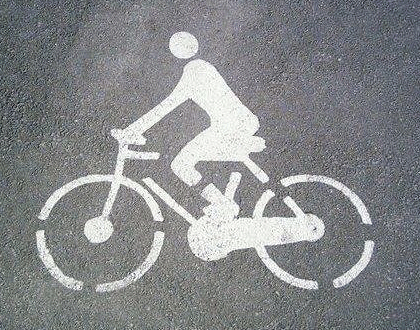 CIRCULATING THE BIKE LANE Use the bike path
CIRCULATING THE BIKE LANE Use the bike path . For your safety, use the bike path whenever you can, even if it involves a small detour on the most direct route.
Be respectful of pedestrians . If you see pedestrians standing or walking along the bike lane, slow down and alert them to your presence with the buzzer. In those areas where many pedestrians travel next to the bike lane and since you cannot foresee the paths they lead, moderate and accommodate your speed to theirs.
Drive wisely . Control your speed, the bike lane is neither a velodrome nor a competition circuit. Do not travel at a speed greater than that which guarantees the safety of all in the existing conditions.
Respect the traffic signs . Don't skip the red lights. With this, in addition to creating dangerous situations, you contribute to the bicycle not being considered a serious and respectable means of transport, discrediting all cyclists.
Avoid dangers . If there are cars parked next to the bike lane, do not drive near them to avoid damage if a door opens unexpectedly.
Respect the rights of pedestrians . As pedestrian crossings are not marked on the bike lane, at any point you can find a pedestrian crossing it: reduce your speed and give way.
Keep both hands on the handlebars . You will react more quickly to any unforeseen event and the braking distance will be shorter.
DRIVING ON THE ROAD If you are forced to circulate on the road with the rest of the traffic when you travel by bicycle, keep the following recommendations in mind:
Find a safe itinerary . Study the itineraries so that you circulate through quiet streets avoiding those with high traffic intensity or those that circulate at high speed.
Stay visible to other drivers . Avoid staying in the blind spot of other drivers.
Respect the traffic signs . Do not skip the red lights, do not drive in the wrong direction, respect the stop signs, etc.
Warn with hand signals . Communicate your movements with your hands in advance, the other drivers will know your trajectory which will increase your safety.
Check that your path is clear . Exercise extreme caution when crossing tram tracks, any type of grating, or when you see a hole or pothole in the pavement. Learn to look back over your shoulder without losing your balance or deviating from your path, thus checking the path of other vehicles.
Keep your track . Do not move to the curb when there are gaps between parked cars, other drivers may not see you when you return to your initial path. Don't zigzag through traffic.
Circulate on your right . The law obliges you to do so. When there are several lanes, it is in the lane on the right where you drive at the slowest speed. If the lane is narrow, for everyone's safety, drive through the center of it.
Turn left safely . While riding a bicycle, you can turn left with the rest of the traffic, but it is safer to do it in two stages, stopping to the right of the vehicles that, waiting for the green, are going in the same direction as you.
Drive in a straight line . Ride to the right of the vehicles that are going faster than you, describing a straight path and separated from the parked vehicles so that you cannot be damaged by a door that opens suddenly.
PEDALE EQUIPPED Make yourself see . Try to wear light or brightly colored clothing. At night use front and rear lights and put reflectors on the bike and your clothes.
Keep your bike in good running condition . The mechanics of the bicycle are simple and require few specialized tools for maintenance. If you do not have the basic knowledge, go to a workshop when you observe any anomaly in accordance with the recommendations detailed below.
Stay in shape . Exercise in your leisure time, with this, traveling by bicycle around the city will cost you less effort and your perspiration will be less.
Pedal insured . As for the rest of the vehicles that circulate on public roads, there are insurance policies that cover damage to third parties, civil liability, etc.
Dress appropriately . Put the helmet on. Gloves increase comfort and protect your hands from the cold. It is recommended that the shoes support the feet firmly and that you dress in layers, to adjust to the changes in temperature throughout the day.
Tie the bike where you leave it . Buy the best lock you can - no lock is as expensive as a new bike. U-locks are more secure. If your bike has quick-clamping devices on the wheels, don't forget to tie both when you leave it unattended.
Planes


